Antonio Arrúe Zarauz
Antonio Arrúe Zarauz (1903–1976) was a Spanish politician and a Basque cultural activist. Politically he was a Carlist militant throughout all of his life; in the 1950s and 1960s Arrue informally led the Gipuzkoan branch of the party, and from 1957 to 1959 he held the official Traditionalist jefatura in the province. Form 1967 to 1971 he served in the Cortes elected from the so-called tercio familiar. He contributed to Basque culture mostly as organizer and administrator, during the Francoist era engaged especially in Euskaltzaindia. His input as linguist or ethnographer is moderate, though he excelled as one of the best Basque-language orators of his time.
Antonio Arrúe Zarauz | |
|---|---|
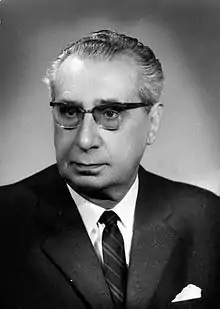 | |
| Born | Antonio Arrúe Zarauz 1903 Asteasu, Spain |
| Died | 1976 San Sebastian, Spain |
| Nationality | Spanish |
| Occupation | lawyer |
| Known for | Basque activist, politician |
| Political party | Comunión Tradicionalista |
Family and youth
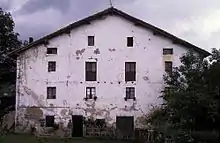
Antonio Arrúe Zarauz[1] was born in the Elizmendi quarter of Asteasu,[2] a small town near Tolosa in the Gipuzkoa province, in the region then known as Vascongadas. None of the sources consulted offers any information on his parents, except that his father, Juan Arrúe, was the first organist in the local San Pedro church;[3] he also served in a number of nearby villages and towns giving lessons.[4] Correct spelling of Antonio's mother's surname is disputed.[5] It is not clear whether the family was in any way related to a number of known contemporary Basques bearing the same name, esp. the Arrúe Valle brothers[6] and the Franciscan musician, José Arrúe.[7] Antonio and his two sisters, Eleuteria and Dolores,[8] were raised in a profoundly Catholic ambience.[9]
The young Antonio obtained his bachillerato in the Lecároz college, run by the Capuchin friars in Elizondo, in the Navarrese region of Valle de Baztán, few miles from the French frontier.[10] In the early 1920s he studied in Oviedo, enrolled at the Faculty of Law in the local university.[11] None of the sources consulted gives exact dates of his academic period. Following graduation he returned to Gipuzkoa and started the career as a lawyer. It is not clear when and where he opened the office; he is first reported by the newspapers as “a young lawyer from Asteasu” in the early 1930s.
In 1941 Arrúe married María Teresa Salazar, a native of Tolosa.[12] The couple settled in San Sebastián; Antonio continued with his law practice, opening the business in the very centre of the city;[13] gradually he specialized in rural rent and heritage issues, working with a number of local companies, associations and institutions.[14] María initially served as a secretary in his law office, later on to work as a seamstress in the garment shop, run by her mother.[15] They had 3 daughters, Maite, María Ignacia and María Carmen. Their only son, Juan María Arrúe Salazar, became a well known donostian lawyer and is referred to as a specialist in urbanismo.[16]
Early career
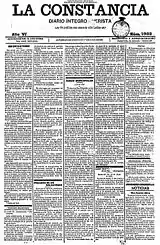
It is not clear whether Arrúe has inherited Traditionalist outlook from his ancestors – like most Carlists in Basque-Navarrese area have – or whether he embraced it during the schooling and academic years. None of the sources consulted offers also any clue as to which branch of the movement he joined in the 1920s, the Jaimistas, the Mellistas or the Integristas, though it is the latter group which seems most probable. Asteasu was in the very centre of the Integrist national stronghold, composed of Tolosa and Azpeitia districts;[17] an Anastasio Arrúe was jefe of the local Tolosan Integrist junta, and a Pedro Arrúe was its treasurer;[18] Antonio's father as an organist was closely related to the parochial clergy; finally, in the early 1930s Antonio commenced collaboration with La Constancia,[19] the local Gipuzkoan Integrist daily, later editing its newly introduced section in Basque.[20]
Arrúe became a public figure after the three Traditionalist streams merged into a united Carlist organization, Comunión Tradicionalista, in 1932. In 1933 he was already reported as an active speaker at local Carlist meetings, mostly in minor Gipuzkoan localities like Isasondo.[21] In the summer of 1934 his activity became indeed hectic and was recorded also in major cities like San Sebastian.[22] Soon gaining recognition as “notable orador”,[23] Arrúe delivered vibrant harangues in Basque that sparked the enthusiasm of the audience.[24] His speeches covered key Carlist topics: siding with the Church against Republican secularization, hailing Gipuzkoan caserios as bulwarks of loyalty, defending traditionalist monarchy as a warrant of regional fueros and confronting Basque nationalism as illusory and deceptive; there were also some social threads present.[25] He spoke firmly against the autonomy draft, denouncing it as "antivasco, antiforal y exótico".[26] Nominated secretary of the Carlist Junta Provincial of Gipuzkoa,[27] he continued with public appearances – already dubbed “infatigable secretario” – throughout 1935[28] and early 1936.[29]
Civil War

It is not clear whether Arrúe contributed either to Carlist military buildup or political preparations to the July 1936 coup, as neither himself nor any of the sources consulted provides any related information.[30] Once it became clear the insurgency failed in Gipuzkoa he went into hiding[31] and resurfaced when the Carlist troops conquered the province. As the Junta Provincial was transformed into the wartime Traditionalist provincial body, Junta Carlista de Guerra of Gipuzkoa, Arrúe resumed his duties of its secretary.[32] Some time late 1936 or early 1937 he became acting president of this body, as its February 1937 documents are already signed by him as "presidente en funciones".[33]
Arrúe soon became disillusioned by military rule in the Nationalist zone, growing particularly anxious about preponderance of Falange in Gipuzkoa and about centralizing designs of the regime, perceived as a threat to Traditionalism, Basque culture and provincial identity.[34] Already in October 1936 the Gipuzkoan Junta Carlista de Guerra, animated by Arrúe, voiced publicly against composition of the provincial comision gestora,[35] bluntly stating that there are two wars: one in the trenches, and one in the corridors of power.[36] Early 1937 he tried to co-ordinate a joint effort of Navarrese, Gipuzkoan and Biscay juntas, aimed at countering falangism and ensuring that provincial fueros do not suffer.[37] Faced with growing threat of amalgamating Carlism within a monopolist state party, just a week between the Unification Decree he signed a circular, urging every Gipuzkoan Carlist to maintain loyalty to the Comunión.[38]
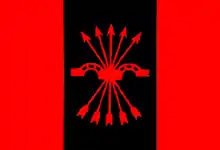
Once Franco decreed abolishment of all parties and their unification within FET, Arrúe decided simply to ignore it. When the new Carlist regent, Don Javier, entered Spain in mid-May, Arrúe accompanied him across Gipuzkoa. On May 19, 1937, he took part in first of the two most emotional moments of his political career: Don Javier swearing at the Guernica oak to conform to and protect the traditional Basque fueros.[39] The pledge soon suffered a major setback when, following the conquest of Biscay, Franco scrapped the provincial concierto economico in June 1937.[40] Standoff between the military and Carlism continued as Don Javier re-entered Spain in November; Arrúe was appointed his personal secretary,[41] touring the frontlines and making 4,000 km across Vascongadas, Castile, Extremadura and Andalusia.[42] In December 1937 the adventure came to an abrupt end when in Granada Arrúe was reached by the military detention order; only thanks to intervention of collaborationist Carlists he was allowed to make it to the Burgos prison himself instead of having been escorted in handcuffs by Guardia Civil.[43] It is not clear how much time he spent behind bars; released, he returned to Asteasu to lead Carlist opposition to falangisation of the province.[44]
Early Francoism
.jpg.webp)
One scholar suggests that having moved with his newly wed wife to San Sebastián, Arrúe rejected proposals to live off perks and administrative positions.[45] Instead, he joined the anti-collaborationist Carlist faction loyal to Don Javier, and threw himself into rebuilding the independent Traditionalist network in the province. In 1940 he was appointed the representative of Gipuzkoa in a 4-member interregional vasco-navarrese junta;[46] the same year the Carlist political leader Manuel Fal Conde suggested he joins executive board of Editorial Navarra, the Carlist publishing house disguised as a commercial enterprise.[47] In August 1942 as head of the Gipuzkoan junta he signed a manifesto prior to planned official celebrations commemorating the siege of Tolosa;[48] the document urged loyalty to Don Javier and Fal, claiming that the future of Spain lies only with Carlism.[49] As the event turned into riots between Carlists and Falangists, Arrúe – accused also of pro-Allies sympathies[50] - was expulsed from Gipuzkoa and ordered a year of exile in Gijon.[51]
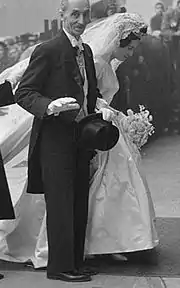
In late 1940s Carlism lost its influence on Gipuzkoan Diputación, FET and major local ayuntamientos.[52] Having returned to San Sebastían Arrúe resumed his semi-official Carlist activities; as the movement decomposed into many factions, he stayed loyal to Fal and the regent. He was with those judging that the regency aroused little enthusiasm amongst the rank-and-file and merely encouraged damaging dynastical competition; hence, he preferred that Don Javier announces his personal claim to the throne, which indeed took place in 1952.[53]
Arrúe maintained very good relations with the Carlist political leader; he shared Fal's intransigence on dynastical and anti-Francoist issues, while Fal shared and supported Arrúe's drive to promote the Basque identity.[54] Though in 1953 the Gipuzkoan junta was reconstituted under Ignacio Ruz de Prada and with Pablo Iturria as its secretary, it was in fact Arrúe remaining the provincial leader.[55] One scholar suggests that Arrúe conspired against Fal, considering him too conventional in his anti-Francoist bid;[56] if this is the case indeed, the ensuing deposition of Fal and collaborationist turn of mid-1950s caught Arrúe bitterly disappointed; he was leaning to a Sivattista dissidence.[57] With José María Valiente emerging as a new national jefe, in 1956 Arrúe tried to oppose his course by forming Junta del Regiones;[58] this semi-rebellious body was bent on preventing rapprochement with Francoism and envisioned a loose alliance of Carlists, nationalists, regionalists, Catholics and even some sectors of the Falange.[59] The junta proved to be short-lived and some of its participants soon backtracked when challenged by Valiente, but Arrúe did not.[60] In 1957 as Gipuzkoan jefe he automatically entered the newly formed Junta de Gobierno de la Comunión[61] and kept confronting the new leader, accusing him of betraying the Carlist spirit.[62] In early 1959 he resigned as jefe of Gipuzkoan Carlism, quoting disagreement with policy of the new Secretariat.[63]
Late Francoism

The Gipuzkoan command was temporarily assumed by junta's vice-president, Luis Zuazola,[64] but the Carlist king did not appoint a new jefe.[65] In the early 1960s Arrúe remained the soul of provincial Traditionalism,[66] apparently driving from the back seat[67] though also assuming one-day prestigious ceremonial roles.[68] When the claimant decided to compete with Basque nationalism by setting up an inter-regional Vasco-Navarrese council named Junta Foral Superior in 1961, Arrúe was considered an obvious representative of Gipuzkoa[69] and a leading candidate to head the entire body. His opponents considered Arrúe a power-hungry Carlist version of Aguirre, keen to build his Vascongadas fiefdom,[70] and as there were no suitable counter-candidates, the idea of Junta Foral was eventually abandoned.[71] In 1962 José Aramburu was formally appointed jefe provincial.[72]
Sidetracking of Arrúe was acknowledged by the regime, always keen to exploit differences within various political groupings, by awarding him Orden del Mérito Civil in 1964.[73] In mid-1960s Arrúe, from 1957 supporting Carlist prince Carlos Hugo,[74] neared the group of his young entourage. He engaged in their new publishing house Ediciones Montejurra[75] and in the spring of 1967 was rewarded with the privilege of addressing the annual Montejurra amassment, the key event in Huguista strategy of grabbing power within the Comunión and a promotional stage for Carlos Hugo himself.[76] Speaking as usual in Basque he focused on regional rights,[77] though his lecture arose little enthusiasm and there were even some jeers recorded.[78]
In late 1967 Arrúe stood as a Carlist[79] in the newly introduced, semi-free elections to the Cortes from the so-called Tercio Familiar,[80] and defeated the governmental candidates in Gipuzkoa.[81] He immediately carried into the parliament the just-launched campaign to re-introduce concierto economico,[82] though despite attempts to mount some public pressure,[83] the initiative came to nothing producing only minor alterations to the original abolition law.[84] As part of a hardly veiled dissident strategy, Arrúe joined procuradores who, unable to get adequate hearing in the chamber, staged rump informal sessions across the country;[85] this “Cortes transhumantes” was formally banned in 1968.[86] In early 1969, together with 3 fellow Carlist MPs, Arrúe protested expulsion of Don Javier and Carlos Hugo.[87]
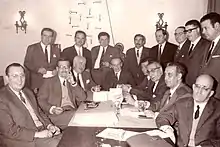
On July 22, 1969, Arrúe recorded the second of the two most emotional moments in his political career: in an open, one-by-one Cortes voting in front of Franco he voiced against Juan Carlos de Borbón as the future king of Spain.[88] Paradoxically, at that time he was increasingly alienated by the pro-democratic turn of the dynasty he remained loyal to. Though when in 1970 Carlos Hugo established his Gabinete Ideologico, Arrúe joined its foral commission, he remained in this body no longer than until 1971.[89] Following a scandal related to re-election negotiations of the Navarrese MPs,[90] he broke up with Partido Carlista, now firmly controlled by the socialist progressists,[91] and did not run in the 1971 elections.[92] He kept considering himself a Traditionalist[93] and an immense portrait of the Carlist king Javier I remained in his office.[94]
Basque: promoter and organizer
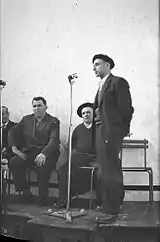
Arrúe's mother tongue was Basque and he spoke Basque also with his own children.[95] Little is known about his early views on the Basque question. In the 1930s he firmly opposed PNV and its political ambitions,[96] confronting them with a traditionalist vision of foral Euskalerria as an integral part of Spain;[97] simultaneously he stood out by delivering all his speeches in Basque, at that time practiced only by some PNV politicians.[98] As a leading Carlist politician in Gipuzkoa, during the Civil War and in the 1940s he showed a concern for Basque culture and for Basque provincial rights, though not for Basque political ambitions.[99]
As some pre-war Basque cultural institutions were getting re-established in the Francoist Spain, Arrúe was increasingly engaged in their activities. In 1953 he assumed co-directorship[100] of Egan,[101] a review issued by Real Academia Vascongada de Amigos del País. It is in Egan that in 1954 he started to publish[102] a regular column[103] dedicated to cuisine[104] and maintained for over 20 years.[105] The same year he commemorated fellow Carlist vascologist Julio Urquijo Ibarra by facilitating foundation of a Basque philology institute bearing his name.[106] When Euskaltzaindia, the Basque language academy, managed to regain its precarious legal standing in the early 1950s, Arrúe neared the institution, to join it formally in 1954.[107] As a lawyer and a politician he was instrumental in organizing its first congress in Aránzazu in 1956,[108] overcoming a number of legal, administrative and political obstacles.[109] He also presided over many of its sessions[110] and was key to engineering the follow-up, vital to the re-launching of Euskaltzaindia after the Civil War.[111]
Relieved from political Carlist duties, in the late 1950s Arrúe fully dedicated himself to Euskaltzaindia. He was the moving spirit behind its newly established commission dedicated to bertsolarism[112] and promoted the genre[113] by organizing local qualifications,[114] leading up to the final contest formatted as a major San Sebastián cultural event in 1960,[115] 1962,[116] 1965 and 1967.[117] He was also a jury member,[118] in case of discrepancies his vote often prevailing.[119] He facilitated a number of editorial initiatives, acknowledged in particular for the Zavala's 1961 launch of Colección Auspoa series[120] and the 1964 re-print of Gero, a monumental 17th century Basque literary work.[121] Some authors claim he also helped to push many works through the Francoist censorship.[122] As an author he popularized Basque culture by writing[123] to La Voz de España, Egan, Euskera, Eusko Gogoa, El Fuerista, Zeruko Argia[124] and by delivering public lectures.[125]
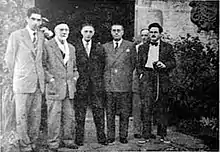
In 1966 he was among initiators of the Euskaltzaindia memorandum to the Ministry of Education, suggesting pilot Basque classes in public schools, limited bilingualism in primary schools and graduation Basque classes in universities,[126] apart from state subventions and limited introduction of Basque in official public use.[127] As a lawyer Arrúe assisted in Aránzazu congress of 1968, vital for building the unified Basque language.[128] In 1969, when Euskaltzaindia's legal standing was challenged, he threw himself into massive lawyer's work, resulting in forming its firm juridical basis in 1972.[129]
Basque: theorist and practitioner
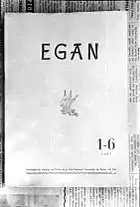
Arrúe, an amateur with no professional background either in linguistics or ethnography, was in the second row of those scientifically contributing to the Basque culture. His works – articles published in Basque- and Spanish-language periodicals, mostly in Egan – are loosely scattered across many disciplines: history of Basque literature,[130] history of Basque linguistics,[131] grammar of Basque language,[132] Basque dialectology,[133] history of Basque social movement,[134] Basque anthropology,[135] theory of contemporary Basque poetry,[136] Basque history,[137] Basque cuisine[138] and foreign literature;[139] it was only the question of Basque political ambitions that he avoided – at least in the Francoist Spain – and usually approached only as part of the Carlist history.[140]
Arrúe's role in theoretical development of the Basque language and culture is perhaps dwarfed by his practical contribution. Since the 1930s he has been hailed by media, colleagues and Vascófilos as a great speechmaker,[141] who has not only transplanted spoken Basque from barns to congress halls, but also brought it to unprecedented rhetorical mastery. Considered one of the best Basque orators of his time,[142] he was acknowledged not for highly emotional inflammatory style, but rather for smoothness, sense of humor, vivacity and fluidity.[143] His practical contribution to written Basque, apart from scientific articles, covers also short poems, usually humorous light pieces like a praise of the Jerez sherry, occasionally winning prizes during local contests.[144]
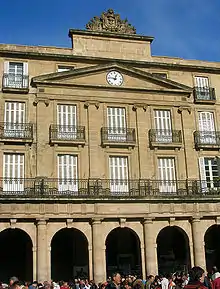
Basque: reception and legacy
Arrúe remained a rather forgotten figure until a compilation of his works was released in 2008 and triggered some follow up both in media and in historiography.[145] According to the recently published works his contribution to the Basque cause is highly controversial. It remains beyond any doubt that he opposed independent Basque political ambitions, defended integrity of Spain and has always considered the Basques part of the Spanish political nation; different views pertain to his intentions and to his impact on Basque culture and Basque national development.
In some studies Arrúe is presented as “one of us”, a Basque who trapped in political maze of his time did his best to promote Basque culture against the hostile background of Francoist regime. He is credited mostly for his support as organizer, lawyer and politician, a person who delivered an umbrella sheltering Basque institutions and enabling cultural development, shaped and directed by the others.[146]
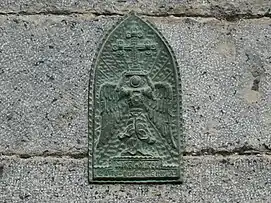
In some studies Arrúe is presented as “a vascófilo within the regime”, a person who tried to accommodate Basque cultural ambitions within the Francoist system. In this perspective, Arrúe appears to be either someone whose contribution was merely a byproduct of his Carlist political leaning, someone who unintentionally promoted the cause, or someone who was used by the Basques to pursue their cultural and national goals.[147]
In some studies Arrúe is presented as a badly reputed "Asteasu beltza".[148] Adherent to a backward ideology, he censored the Basque literature,[149] forced pro-Francoist distortions,[150] promoted clericalism,[151] sponsored Spanish lexical intrusions into Basque,[152] obstructed disliked people and publications[153] and manipulated bertsolari contests in terms of their winners[154] and in terms of their public reception.[155] In a nutshell, according to this view Arrúe was nothing less than a Francoist “political commissar” delegated to Euskaltzaindia,[156] and his activity remained detrimental to Basque national development.[157]
See also
Footnotes
- Not to be confused with Antonio Arrué Peiró, a contemporary Spanish martyr (1908–1936) beatified by the Catholic Church (see here) and also a controversial figure related to the Spanish Civil War.
- Manuel Martorell Pérez, Antonio Arrue, el carlista que colaboró en el relanzamiento de Euskaltzaindia, [in:] Euskera 56 (2011), p. 849
- winning the competition of 1888, aiurri.com service available here Archived 2016-02-02 at the Wayback Machine; see also Ángel Sagardia Sagardia, Ángel Cabanas Erausquin entry at Auñamendi Eusko Entziklopedia available here and aramburu blog available here
- Antonio Zavala, Presentación, [in:] Antonio Arrue. Idaztiak eta hitzaldiak, Bilbo 2008, ISBN 9788495438423, p. XII
- Arrúe’s segundo apellido is usually spelled as “Zarauz”, compare the official Cortes service available here, though some authors prefer the “Zarautz” version, see Joxemiel Bidador, Antonio Arrue Zarautz, a 2000 entry [in:] zubitega service available here;
- Jose, Ramiro and Ricardo, see their personal entries at Auñamendi Eusko Entziklopedia available here, here and here
- see Arrue, José de (1884-1960) entry at eresbil.com service available here
- Zavala 2008, p. XII
- though somatimes his relations with the clergy remained thorny, see Luis Villasante Kortabitarte, Antonio Arrue jauna hil zaigu [in:] argia.eus service available here
- Zavala 2008, p. XII, also Bernardo Estornés Lasa, Antonio Arrúe Zarauz entry at Auñamendi Eusko Entzikopedia, available here
- Martorell Pérez 2011, p. 855, Estornés Lasa, Antonio Arrúe Zarauz
- during their engagement period Arrúe travelled on bike from his home to Villabona, half-way between Asteasu and Tolosa, to meet his fiancée on "neutral ground", see Martorell Pérez 2011, p. 849, see also ABC 11.10.05, available here
- first at calle Legazpi, later move to calle de Garibay, Martorell Pérez 2011, p. 855
- Martorell Pérez 2011, p. 855, Bernardo Estornés Lasa, Antonio Arrúe Zarauz
- Martorell Pérez 2011, p. 855
- see laboratoriodefilosofia service available here Archived 2015-01-31 at the Wayback Machine, also infoempresa service availavle here; like his grandfather, Juan Arrúe Salazar also used to plays organs in Asteasu, see Diario Vasco 29.06.11, available here
- see Javier Real Cuesta, El Carlismo Vasco 1876-1900, Madrid 1985, ISBN 8432305103, 9788432305108, pp. 113-127, 254-269; in the Azpeitia district the Integrists won 13 out of 22 Cortes mandes conquered during the Restoration age
- El Siglo Futuro 22.05.06, available here; there were also other members of the Arrue family active as Integrist supporters in the district, see El Siglo Futuro 07.08.95, available here 1
- Juan San Martin, Antonio Arrue, [in:] Egan 1/6 (1976), p. 16, available here
- some authors claim it was as early as in 1932, see San Martin 1976, Bidador 2000; bibliographical entry of La Constancia at the San Sebastián digital press archive claims the Basque section was introduced in 1934, see here
- El Siglo Futuro, 28.08.33, available here, also El Siglo Futuro 07.10.33, available here
- in May he spoke in San Sebastian (see El Siglo Futuro 05.05.34 available here), in June in Ganza (El Siglo Futuro 09.06.34, available here) and Goyaz (El Siglo Futuro 15.06.34, available here), in July in Bedayo (El Siglo Futuro 12.07.34, available here) and Zarauz (El Siglo Futuro 14.07.34, available here), in August in Renteria (El Siglo Futuro 18.08.34, available here)
- El Siglo Futuro 18.08.34, available here
- see e.g. El Siglo Futuro 28.08.34, available here
- compare El Siglo Futuro 09.08.34, available here, La Epoca 23.12.35, available here, and especially El Siglo Futuro 23.12.35, available here
- El Siglo Futuro 09.08.35, available here
- El Siglo Futuro 16.07.34, available here
- El Siglo Futuro 14.08.35, available here, El Siglo Futuro 20.08.35, available here, El Siglo Futuro 16.10.35, available here, El Siglo Futuro 01.11.35, available here, El Siglo Futuro 02.11.35, available here, El Siglo Futuro 04.11.35, available here, El Siglo Futuro 10.12.35, available here
- El Siglo Futuro 13.02.36, available here
- Manuel Martorell Pérez, Carlos Hugo frente a Juan Carlos: La solución federal para España que Franco rechazó, Madrid 2014, ISBN 8477682658, 9788477682653, p. 229 states vaguely that Arrúe contributed to insurgency preparations, though he gives neither a source nor any details
- Martorell Pérez 2011, p. 850, Zavala 2008, p. XIII
- Martorell Pérez 2011, p. 850
- Martorell Pérez 2011, p. 852
- Martorell Pérez 2011, p. 851
- the Junta published its statement in La Voz de España, declaring that “con relación a la nota de la F .E. de las JONS aparecida en Unidad, la Junta Carlista de Guerra de Guipúzcoa desea hacer público que lamenta no poder adoptar actitud análoga a la que se expresa en dicha nota, por no haber recibido invitación alguna del Excmo. Sr. Gobernador Civil para participar en la nueva Gestora Provincial . Por consiguiente esta Junta no ha facilitado ningún nombre para la provisión de puestos en el referido organismo”, quoted after Félix Luengo Teixedor, La formación del poder franquista en Guipúzcoa (1937-1945), [in:] Geronimo de Uztariz 4 (1990), p. 86
- “Hay dos guerras, la de las trincheras, donde se expone la vida y se juega con la muerte, y la de las ciudades, donde se exponen cargos y se juega con los nombres (. . .) En la retaguardia hay una guerra sórdida y miserable, en la que empuja y se trabaja arteramente por medrar y subir, por colocarse y brillar”, quoted after Teixedor 1990, p. 86
- Martorell Pérez 2011, p. 851, further details in Teixidor 1990, pp. 84-86
- Martorell Pérez 2011, p. 852
- Martorell Pérez 2011, p. 852; the oath was taken by capelan of the Requetés and the pason of Ezquiroz, Fermín Erice, Martorell Pérez 2014, p. 229, see also video homage at 02:52
- Martorell Pérez 2011, p. 853; other sources claim it was in July 37, see Teixedor 1990, p. 88
- Martorell Pérez 2014, p. 229
- Martorell Pérez 2011, p. 853
- Martorell Pérez 2011, p. 853-4; Don Javier was expulsed from Spain soon afterwards, Manuel Martorell Pérez, La continuidad ideológica del carlismo tras la Guerra Civil [PhD thesis in Historia Contemporanea, Universidad Nacional de Educación a Distancia], Valencia 2009, p. 154
- Gobernacion civil was already fully controlled by FET, though Carlism remained in control of Diputación Provincial, see Teixedor 1990, p. 88; key front-office Carlists in Gipuzkoa were at that time Julio Muñoz Aguilar (jefe of provincial FET), Fidel Azurza (president of Diputación, jefe provincial de FET), Juan José Pradera (director of La Voz de Espana). Elías Querejeta (jefe of provincial FET), Lus Ruiz de Prada (president of Diputación) and Fernando Aramburu (president of Diputación), Teixedor 1990; another author describes them as “poco representativos”, see Mercedes Vázquez de Prada Tiffe, La reorganización del carlismo vasco en los sesenta: entre la pasividad y el "separatismo", [in:] Vasconia. Cuadernos de Historia-Geografía, 38 (2012), p. 1123
- Martorell Pérez 2011, p. 855
- Martorell Pérez 2011, p. 855, Martorell Pérez 2009, p. 194
- Martorell Pérez 2011, p. 855
- also Fernando Aramburu as president of Diputación protested against the Francoist treatment of Gipuzkoa; he was forced out of office in October 1942, Teixedor 1990, p. 91
- Arrúe urged to “defender con todo su entusiasmo la bandera de la legitimidad, hoy en alto mantenida por nuestro Regente Don Francisco Javier de Borbón-Parma y su Delegado y único jefe de la Comunión Tradicionalista Sr.D. Manuel Fal Conde [...] ¡¡ Carlistas guipuzcoanos!! el próximo día 9 de agosto todos a Tolosa, a demostrar que aún se puede salvar a España con el carlismo y solamente con el carlismo”, quoted after Martorell Pérez 2011, p. 856
- Martorell Pérez 2011, p. 856, Martorell Pérez 2009, p. 274, see also here; for an anti-British view, see here
- Martorell Pérez 2011, p. 855, Zavala 2008, p. XIII he was fined, see Martorell Pérez 2014, p. 229
- Teixedor 1990, pp. 92-3
- Martorell Pérez 2011, p. 857
- Martorell Pérez 2011, pp. 858-9, Martorell Pérez 2009, p. 344
- Martorell Pérez 2011, p. 858, Martorell Pérez 2009, pp. 343-4; the Gipuzkoan junta was not assembled for long periods, all powers resting with Arrúe, Vázquez de Prada 2012, p. 1124
- Martorell Pérez 2009, p. 392; the same author in his other work claims that Arrúe has been loyal to Fal, see Martorell Pérez 2011, p. 850
- he was present during the talks between Don Javier and the Sivattistas in Perpignan; the meeting ended with Don Javier signing a document pledging faith to Traditionalist principles and ruling out a dynastical agreement with the Alfonsists. The paper was supposed to be private, but Sivatte made it public. A number of signatories were later expulsed from the Comunion; Arrue was spared due to his recent appointment to the provincial jefatura, Mercedes Vázquez de Prada, El final de una ilusión. Auge y declive del tradicionalismo carlista (1957-1967), Madrid 2016, ISBN 9788416558407, pp. 45-46
- Martorell Pérez 2009, p. 394; Martorell Pérez 2014, p. 112; a bit different view Mercedes Vázquez de Prada Tiffe, El nuevo rumbo político del carlismo hacia la colaboración con el régimen (1955-56), [in:] Hispania 69 (2009), pp. 193-196
- Martorell Pérez 2011, p. 859; Arrúe held separate talks with Arrese, bordered disloyalty to Don Javier, Vázquez de Prada 2009, p. 198
- Martorell Pérez 2011, p. 859
- Vázquez de Prada 2009, p. 199, Vázquez de Prada 2012, p. 1116; Bernardo Estornés Lasa, Antonio Arrúe Zarauz, claims that Arrúe was also a member of “Junta suprema”, “Diputación permanente” and “Junta nacional” of the Comunión, but none of these bodies is identified or mentioned by other scholars
- Martorell Pérez 2011, p. 859, he is described as “representante del sector más intransigente del carlismo vasco”, Martorell Pérez 2009, p. 415
- Martorell Pérez 2011, pp. 859-60, Martorell Pérez 2014, p. 113; it is not clear when Arrúe has earlier re-taken junta's presidency from Ruiz de Prada
- Vázquez de Prada 2012, p. 1131
- a local commission, called in 1959 and composed of José Ignacio Olazábal, Elías Querejeta and Germán Raguán suggested that Luis Zuazola is the best candidate for the new jefe, Vázquez de Prada 2012, p. 1124
- Vázquez de Prada 2012, p.1132; the front-men were José Aramburu, José Ignacio Olazábal, Luis Zuazola and Germán Raguán Vázquez de Prada 2012, p. 1125
- according to Raguán Zuazola used to sign everything approved by Arrúe, Vázquez de Prada 2012, p. 1135; the author considers Gipuzkoan leadership team Arrúe’s camarilla, see Vázquez de Prada 2012, p. 1135
- in 1960, during celebrations of 125th anniversary of Zumalacarregui’s death, Arrúe addressed the crowd in front of the martyr’s mausoleum; speaking of course in Basque he underlined that no Spanish king is legitimate unless he swears to the Basque fueros, a hardly veiled reference to Don Javier’s oath taken in 1937, Martorell Pérez 2011, p. 863
- along a veteran Gipuzkoan Carlist and former president of the Gipuzkoan Diputacion Provincial, Julián Elorza Aizpuru
- Vázquez de Prada 2012, pp. 1132-5
- Vázquez de Prada 2012, p. 1136
- Vázquez de Prada 2012, p. 1125
- Martorell Pérez 2011, p. 849, San Martin 1976, p. 16
- In 1957 Arrúe supported the idea of Carlos Hugo making a surprise entry at Montejurra, see Martorell Pérez 2009, p. 415, Martorell Pérez 2014, p 84; he was also in the first line during the ceremony itself, Martorell Pérez 2009, p. 416, Martorell Pérez 2014, p 85. It is not clear why Arrúe supported the prince; maybe he considered Carlos Hugo and the Huguistas a counter-weight to Valiente, maybe he hoped that a young prince would provide more dynamics while Don Javier was already aging, maybe he viewed prince’s entry as a means of strengthening the dynasty against the Juanistas, especially that Arrúe has already pressed Don Javier on descendancy issues, Vázquez de Prada 2009, p. 198
- Martorell Pérez 2011, p. 863-4
- compare Jeremy MacClancy, The Decline of Carlism, Reno 2000, ISBN 9780874173444, pp. 127-156
- note also the social thread: “las regiones fueron las constructoras de la nación y hoy son la columna viva que sostiene la sociedad en que vivimos,” quoted after Martorell Pérez 2014, p. 224; “sólo en la unidad de España tienen sus limites las libertades regionales”, quoted after La Vanguardia 13.05.67, available here
- Francisco Javier Caspistegui Gorasurreta, El naufragio de las ortodoxias: el carlismo, 1962-1977, Pamplona 1997, ISBN 8431315644, 9788431315641, p. 302, Vázquez de Prada 2016, p. 310
- there was much trust in the Comunion that Arrue would ensure the Carlist success in Gizpuzkoa, Vázquez de Prada 2016, p. 326
- Martorell Pérez 2014, p. 250
- Martorell Pérez 2011, pp. 850, 869, see also the official Cortes service here
- the campaign was launched in by the Carlist councillors of the Tolosa ayuntamiento, Martorell Pérez 2011, pp. 864–5, 866
- in 1967 he led a public gathering at the main plaza of Estella; flanked by immense portraits of Don Javier and Carlos Hugo and following a folk performance of Muthiko Alaiak, Arrúe addressed a see of boinas rojas; first in Basque and later in Castellano he declared that Carlism supports the campaign to restore the concierto
- the government merely agreed to remove part of the preamble, which implied that Gipuzkoa and Biscay were punished for their pro-Republican stance in 1936; as the very text the Francoist government declared that there is no step back, Martorell Pérez 2011, p. 865
- La Vanguardia 19.01.68, available here
- Stanley G. Payne, The Franco Regime, Madison 1987, ISBN 0-299-11070-2, p. 517
- La Vanguardia 10.01.69, available here
- as one of 4 Carlists and 19 procuradore in total, Martorell Pérez 2011, p. 870; see the Pathe film with part of the procedure (starting 02:55), available here
- Comisione Delegada Para el Estudio Foral y Local, Caspistegui Gorasurreta 1997, p. 204
- José-Angel Zubiaur Alegre and Auxilio Goñi Donázar, two Carlist MPs from Tercio Familiar who like Arrúe voted against declaring Juan Carlos in 1969, during preparations to the 1971 re-election campaign were required by Don Javier and his entourage to sign their undated resignations prior to running as Carlist candidates; enraged, they refused, see José-Ángel Zubiaur Alegre, José-Ángel Zubiaur Carreño, Elecciones a Procuradores familiares en Navarra en 1971, [in:] Aportes 27/79 (2012), pp. 147-167
- Martorell Pérez 2011, p. 863; he declared: “yo continuaré siendo carlista hasta la muerte. Pero con Carlos Hugo y los suyos no quiero saber nada”, quoted after Zavala 2008, p. XIII
- it is not clear whether Arrúe was required to sign the same resignation letter as the Navarrese Carlist procuradores were; Zubiaur Alegre 2012 does not mention his name
- Martorell Pérez 2011, p. 863; „en politica fui siempre tradicionalista”, quoted after Zavala 2008, p. XII
- Martorell Pérez 2011, p. 871
- Zavala 2008, p. XIX
- “en primer lugar hizo uso de la palabra D. Antonio Arrúe, que habló en vasco, haciendo un llamamiento a los regionales para que no se dejen sorprender por las doctrinas que él califica de nuevas y que no son más que un morbo separatista, con las que la tradición está en abierta pugna”, El Sol 24.12.35, available here
- called “para luchar por Dios, por España y por Euskalerria”, see El Siglo Futuro 13.02.36, available here
- San Martin 1976, p. 16
- Martorell Pérez 2011, pp. 851, 858-9, Martorell Pérez 2009, p. 344
- with Aingueru Irigaray and Koldo Mitxelena
- Martorell Pérez 2011, p. 860, Bernardo Estornés Lasa, Antonio Arrúe Zarauz
- as A.A.
- titled Jan edenak; full archive available here
- Arrúe was a refined gourmet expert. He had a huge library on the subject, Zavala 2008, p. XVI, co-founded Cofradía Vasca de Gastronomía, Martorell Pérez 2011, p. 862, took part in conferences on gourmet, see La Vanguardia 12.11.68, available here and won prizes for his writing on cuisine, La Vanguardia 17.12.63, available here
- his contributions were gathered and reprinted in 1979, Martorell Pérez 2011, p. 860
- exercising whatever influence he still had in local politics, Bidador 2000
- Zavala 2008, p. XIII and San Martin 1976, p. 16 claim it was in 1954
- Martorell Pérez 2011, p. 860, Zavala 2008, p. XIII
- Zavala 2008, p. XIV, Martorell Pérez 2011, p. 861
- Zavala 2008, p. XIV
- Martorell Pérez 2011, p. 861
- Zavala 2008, p. XV
- Martorell Pérez 2011, p. 861
- in the immediate post-war era bertsolarim was reduced to very low-ley events, virtually family and friend meetings
- ABC 20.12.60, available here
- Zavala 2008, p. XV, see also ABC 01.01.68, available here
- Martorell Pérez 2011, p. 861, Zavala 2008, p. XV
- the circle of bertsolarismo promoters was formed by Juan María Lecuona, Alfonso Irigoyen, Fernando Artola, Antonio Valverde, Ambrosio Zaratain Juan San Martín and Antonio Zavala, Martorell Pérez 2011, p. 862, Zavala 2008, p. XV
- Zavala 2008, p. XVI
- Martorell Pérez 2011 p. 862
- Martorell Pérez 2011, p. 862; he also helped financially, see Zavala 2008, p. XVI, Bernardo Estornés Lasa, Antonio Arrúe Zarauz
- Zavala 2008, p. XX, Luis Villasante, Antonio Arrue Zarauz (1903–1976), [in:] Jan-edanak, Donostia 1979, ISBN 8472314677, 9788472314672, available also here
- also under the pen-name Urrea, Arrue Zarauz, Antonio entry [in:] Harluxet hiztegi entziklopedikoa, available here
- Bidador 2000
- Martorell Pérez 2011, p. 864
- Martorell Pérez 2011, p. 866
- Martorell Pérez 2011, p. 867
- Martorell Pérez 2011, p. 869
- Zavala 2008, p. XVII, Villasante 1979; the case was finally settled in 1976, Zavala 2008, p. XVIII
- e.g. Juan Bautista Agirre (1954)
- e.g. Itzaurre-bidez (1956)
- e.g. Gerriko (1956)
- e.g. Euskareran batasuna (1956)
- e.g. Palankariak (1958)
- e.g. Euskal umoreaz (1961)
- e.g. Cuatro poetas vascos actuales (1963)
- e.g. San Sebastián y la Real Compaña Guipuzcoana de Caracas (1963)
- e.g. Gastronomía vasca (1967)
- e.g. Turoczi (1958)
- E.g. Zumalakarregi (1960)
- invited and wanted also abroad, see Zavala 2008, p. XVIII
- Bernardo Estornés Lasa, Antonio Arrúe Zarauz
- Martorell Pérez 2011, p. 861, Zavala 2008, p. XVIII
- La Vanguardia 24.08.72, available here
- Martorell Pérez 2011, p. 849; Arrúe’s friends and colleagues from Euskaltzaindia arranged for his works to be issued as a book in 2008; for a sample of press acknowledgements see Diario Vasco 03.05.09, available here; brief historiographical debate ensued in Euskera of 2011 and 2012
- see apologetic article by Manuel Martorell Pérez 2011 or the homage paid by Antonio Zavala 2008; Luis Villasante 1979 calls him friend and colleague and wishes “may he help for us from heaven”
- see biographical note edited by Joxemiel Bidador 2000 or Arrue Zarautz, Antonio entry at Lur hiztegi entziklopedikoa available here
- very loosely translatable as “Darth Vader from Asteasu”; this approach is presented by Pako Sudupe, Antonio Arrue: Euskaltzaindiaren eta Francoren erregimenaren laguntzaile, [in:] Euskera 57 (2012), pp. 823-838, based on own research and evidence provided by Nemesio Agapito Echániz Arambarri and Andima Ibiñagabeitia Idoyaga
- enforcing also self-censorship upon the authors, Sudupe 2012, p. 829
- in re-issued edition of Peru Abarca the original prologue is replaced by the one written by Arrue, Sudupe 2012, p. 829
- Sudupe 2012, p. 831; the same author claims that Arrúe, in the best Soviet style, manipulated the clergy, see p. 836
- Sudupe 2012, p. 831
- Sudupe 2012, p. 835
- Sudupe 2012, pp. 834-5
- Sudupe 2012, p. 834 quotes Nemesio Echániz speaking allegedly on Arrúe: “En todas las fiestas populares euskéricas, un señor que ya desde antaño tenía dadas buenas muestras de su fobia hacia todos los que no se allanaran a sus estrechas ideas políticas, se arroga el derecho de soltar una soflama euskérica con latiguillos fáciles de un pretendido entusiasmo vasquista”.
- Sudupe 2012, p. 834
- see damaging accounts by Echániz and Ibiñagabeitia referred by Sudupe 2012, pp. 836-7
Further reading
- Manuel Martorell Pérez, Antonio Arrue, Euskaltzaindiaren suspertzean lagundu zuen karlista, [in:] Euskera 56 (2011), pp. 847–872
- José Javier López Antón, Escritores carlistas en la cultura vasca: sustrato lingüístico y etnográfico en la vascología carlista, Tafalla 2000, ISBN 8476813260
- Juan San Martin, Antonio Arrue, [in:] Egan 1/6 (1976), pp. 15–17
- Pako Sudupe, Antonio Arrue: Euskaltzaindiaren eta Francoren erregimenaren laguntzaile, [in:] Euskera 57 (2012), pp. 823–838
- Antonio Zavala, Aurkezpena, [in:] Antonio Arrue. Idaztiak eta hitzaldiak, Bilbo 2008, ISBN 9788495438423, pp. XII–XXV
External links
- Arrúe at Euskomedia
- old photos of Lecaroz college
- Arrúe at literaturaren zubitegia site
- Egan archive
- Euskaltzaindia official site
- Eta tira eta tunba, eta tira beltzari, traditional Basque Carlist song
- Oriamendi euskera, Carlist anthem in its original Basque version
- contemporary Carlist propaganda video (Arrúe 2:53, centre, with spectacles)